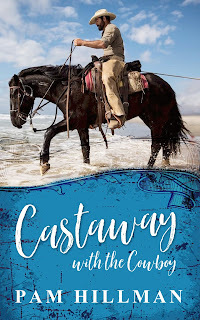Erica Vetsch's Blog, page 49
October 24, 2021
Writing is a Team Sport

Howdy! Erica Vetsch here! I hope you’re having a splendiferous day!
This last weekend, I turned in the content edits for my 2022 release, Millstone of Doubt, book two in the Thorndike & Swann Regency Mysteries.
I spent hours in my library/office, reading, revising, tweaking, fixing. The door was closed, a little instrumental piano music going in the background, tea mug nearby. I was alone with my work.

This is the point where you hear authors say writing is very solitary. You. The Words. Nobody else. And this is true. There are great swaths of my day where I am by myself, at my computer, pulling words from my head and arranging them on the screen.
And yet, while authors write their books in isolation, writing is really a team sport. And the broader writing life even more so.
Examples just from this past week:
1. I edited Millstone of Doubt based upon the editorial letter I got from my editor at the publishing house. We are a team, trying to produce the best product possible. We shared ideas, collaborated on sticky bits, and hopefully succeeded in making the manuscript better. The book will now go to the line editor, who will polish, align, and generally improve the story in most every way possible because she’s awesome like that. Yay for an editorial team!

2. I spoke with my publicist on the phone, and she did some cooperative marketing for a project I was involved with. Very soon, she’ll be sending me Q&As for my upcoming release, creating graphics, and checking up on all the people who have signed up to read and review the story in the coming days. She works with the marketing and publicity teams at my publisher to get the word out about my books. Yay for a publicity team!

3. Last week, I took part in the Christian Fiction Scavenger Hunt with 25 other authors. We each promoted the hunt through our social media, newsletters, and pretty much everywhere we could, and as a result, word about my upcoming release reached WAY more people than I could have on my own. Yay for a collaborative effort by a team of author friends.
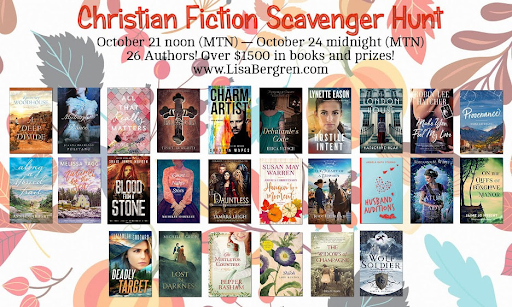
4. Last Thursday, I did a zoom meeting with a delightful group of west coast librarians where we talked about the road to publication, books, our favorite reads, and more. But on Tuesday, I couldn’t think of a single topic that would sound interesting. I was up to my eyeballs in edits, had several other projects going, and my mind was blank…so…I threw myself on the mercy of the Seekers. Dashing off a quick email plea for help, I was thrilled that so many ideas and answers poured into my inbox. I knew they would, because the SeekerLadies are awesome like that. In the end, I think I hit on almost every proposed topic in my presentation, and the librarian ladies seemed to enjoy it and had lots of fun questions afterwards. Yay for a writing buddy team!

5. This past week, I also got together with writing friends, Julie Klassen and Michelle Griep, to film a fun video we hope to air in the Inspirational Regency Readers Group in December. They drove to my place, brought props, and basically joined in on my hare-brained schemes. J They were great, and I could not (and would not) have done the video without them. My daughter took the day off from work to be our videographer, and she rocked it! Yay for the friend and film crew team!
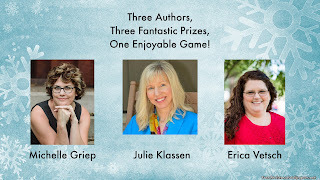
6. I also met on Friday with a book club two hours from my home. We got together to fellowship and to make some crafts and of course to talk about books. This group of ladies has supported Christian fiction as a book club for more than 15 years, and they’re still going strong. I just love them. They encourage me every time we get together. Yay for a reader team!

7. Last night (I’m writing this on Saturday for a Monday post, so that tells you how busy my week has been) I got a reminder from our own Mindy Obenhaus about getting my updates into the Weekend Edition post. Mindy does this every week, reminding those who posted before and those who are due to post to get their blurbs in and pick winners, etc. Audra Harders creates the lovely Seekerville calendars each month, Seekers cover for each other if someone cannot post on their day, Ruthy sorta stage-manages us all, Debby produces the lovely Sunday Prayer posts, and…you would not believe the fervent and faithful prayers that surround any Seeker in need. Yay for a tight team of Seekers!
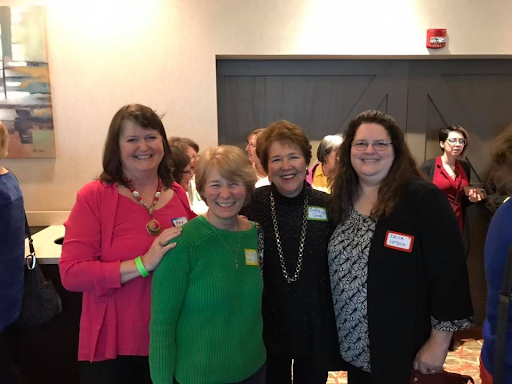
As you can see, my writing life has been a wee bit on the busy side, but it hasn’t all been sitting alone in my office staring at that judgmental blinking cursor all day. I have teams of people who have helped me accomplish every aspect of my writing life. I haven’t even mentioned my husband who has spent several evenings in sole possession of the remote control as I worked on edits into the late hours, nor how next week, Heather will be helping me plot my next novel so I can dive into writing it, or my church family who lent prayer and care while my husband and I were sick with the current virus du jour.
Do you have a team? Are you part of someone else’s team?
 Best-selling, award-winning author Erica Vetsch loves Jesus, history, romance, and sports. She’s a transplanted Kansan now living in Minnesota, and she is married to her total opposite and soul mate! When she’s not writing fiction, she’s planning her next trip to a history museum and cheering on her Kansas Jayhawks and New Zealand All Blacks. You can connect with her at her website, www.ericavetsch.com where you can read about her books and sign up for her newsletter, and you can find her online at https://www.facebook.com/EricaVetschAuthor/ where she spends way too much time!
Best-selling, award-winning author Erica Vetsch loves Jesus, history, romance, and sports. She’s a transplanted Kansan now living in Minnesota, and she is married to her total opposite and soul mate! When she’s not writing fiction, she’s planning her next trip to a history museum and cheering on her Kansas Jayhawks and New Zealand All Blacks. You can connect with her at her website, www.ericavetsch.com where you can read about her books and sign up for her newsletter, and you can find her online at https://www.facebook.com/EricaVetschAuthor/ where she spends way too much time!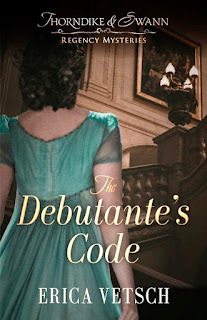
Jane Austen meets Sherlock Holmes in this new Regency mystery series
Newly returned from finishing school, Lady Juliette Thorndike is ready to debut in London society. Due to her years away, she hasn't spent much time with her parents, and sees them only as the flighty, dilettante couple the other nobles love. But when they disappear, she discovers she never really knew them at all. They've been living double lives as government spies--and they're only the latest in a long history of espionage that is the family's legacy.
Now Lady Juliette is determined to continue their work. Mentored by her uncle, she plunges into the dangerous world of spy craft. From the glittering ballrooms of London to the fox hunts, regattas, and soirees of country high society, she must chase down hidden clues, solve the mysterious code her parents left behind, and stay out of danger. All the while, she has to keep her endeavors a secret from her best friend and her suitors--not to mention nosy, irritatingly handsome Bow Street runner Daniel Swann, who suspects her of a daring theft.
Can Lady Juliette outwit her enemies and complete her parents' last mission? Or will it lead her to a terrible end?
You can pre-order HERE.
October 23, 2021
Sunday Scripture & Prayer Requests
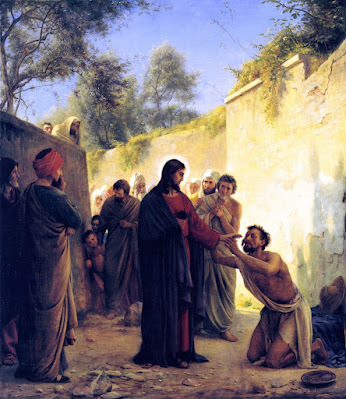 Healing of the Blind Man by Jesus Christ, Carl Bloch,
Healing of the Blind Man by Jesus Christ, Carl Bloch,
1871, Museum of National History. [PD-US]
As Jesus was leaving Jericho with his disciples and a sizable crowd,
Bartimaeus, a blind man, the son of Timaeus,
sat by the roadside begging.
On hearing that it was Jesus of Nazareth,
he began to cry out and say,
"Jesus, son of David, have pity on me."
And many rebuked him, telling him to be silent.
But he kept calling out all the more,
"Son of David, have pity on me."
Jesus stopped and said, "Call him."
So they called the blind man, saying to him,
"Take courage; get up, Jesus is calling you."
He threw aside his cloak, sprang up, and came to Jesus.
Jesus said to him in reply, "What do you want me to do for you?"
The blind man replied to him, "Master, I want to see."
Jesus told him, "Go your way; your faith has saved you."
Immediately he received his sight
and followed him on the way.
Mark 10:46-52
The Seekerville bloggers are praying for YOU and for our entire blog community. If you have any special intentions that need additional prayer coverage, leave a request for prayer in the comment section below.
Please join us in praying for our country!God Bless the USA!We are so grateful for all of you—for your friendship and your support!
May the Lord bless you and keep you safe.
October 22, 2021
Weekend Edition


If you are not familiar with our giveaway rules, take a minute to read them here. It keeps us all happy! All winners should send their name, address, and phone number to claim prizes. Please send to Seekerville2@gmail.com. If the winner does not contact us within two weeks, another winner may be selected.
Monday: Jan shared some great ideas for choosing your setting. Stay tuned for part two of the post on the third Monday of November!
Wednesday: Debby Giusti shared her "Checklist for First Chapters."
Friday: Pam shared tips on taking one idea and repurposing it to get the most bang for your buck, or mileage out of your time. Check it out!

Monday: Erica will talk about how Writing is a Team Sport!
Wednesday: Cate is here with another in her series on favorite craft books. Friday: ?


Seeker Glynna Kaye’s 2016 “The Pastor’s Christmas Courtship” has been reissued as a 2-in-1 along with author Jill Kemerer!
The Pastor's Christmas Courtship by Glynna Kaye
Jodi Thorpe's childhood vacation cabin seems the perfect place for her to heal her broken heart…and avoid Christmas cheer. After twelve years, nothing in Hunter Ridge has changed—except Garrett McCrae. The bad boy who was once her secret crush is now the town minister. And Garrett won't let her miss out on the joy of the holiday, even as he's about to leave for a mission halfway around the world…
Yuletide Redemption by Jill Kemerer
All Celeste Monroe wants is to give her orphaned baby nephew a happy life. She hopes taking a job caring for injured Sam Sheffield will help fulfill that goal. Celeste’s strength and kindness have Sam falling for her—and her baby. But he refuses to burden them with a man who’s not whole. Can Celeste convince Sam he’s father—and husband—material in time for Christmas?
Castaway with the Cowboy (A Calico Trails Romance)by Pam Hillman
When an explosion sinks their steamship, horse wrangler Zach Holifield and nanny Abby Lindstrom find themselves stranded on a deserted island in the Caribbean. Along with Abby’s two young charges, a cabin boy, and a couple of missionaries, Zach and Abby struggle for survival, normalcy, and a chance to live, to love, and to grow old together.
BUY HERE!

An Amish Spring Anthology and Debby Giusti is one of the authors.
To learn more join the FB Reader Group
Amish Spring Romance | Facebook
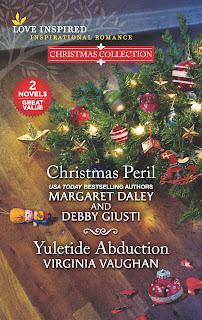 Available now at your favorite bookstores!
Available now at your favorite bookstores!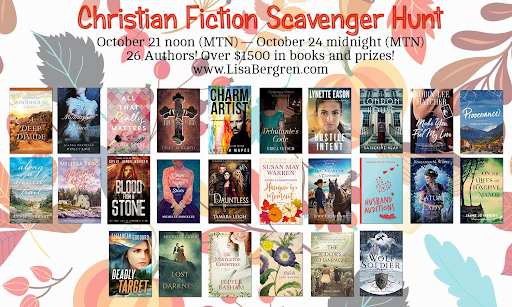
Erica and a bunch of her friends are taking part in the Christian Fiction Scavenger Hunt, where there areover $1500 in books and prizes available, as well asMANY individual prizes on the various authors' websites.The hunt is open through tomorrow, and you can start Here:https://lisatawnbergren.com/2021/10/christian-fiction-scavenger-hunt-stop-1-9/Follow the hunt from one author's site to the next, collecting the clues, then fill out the form at the end to be entered to win one of thefabulous prizes! Don't forget to enter the individual giveaways going onright now on the authors' sites, too. Here's a peek at the prize packageavailable on my site:
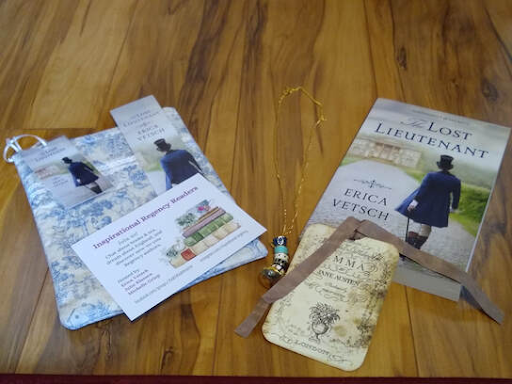

5 Ways to Make Animated Templates Work For You by LA Sartor at Book Brush Blog
Spreading the Written Word in a Video World by Sharon Bially at Writer Unboxed
How to Research Your Book by Vikki Carter at The Creative Penn
How to Make Your Character's Choices More Difficult by Angela Ackerman at Helping Writers Become Authors
15 Ways Authors Support Each Other on Social Media by Leila Hirshfeld at BookBub Partners
NaNoWriMo: Planning Your Novel's Middle by Janice Hardy at Fiction University
How to Create a Writing Space by Michelle Sass Aleckson at Learn How To Write A Novel
Using Conflict to Build Tension by Sue Colleta at Kill Zone Blog
What's Your Writing Why? by Tammy Karasek at The Write Conversation
Failure, Conflict, and Character Arc by Becci Puglisi at Writers In The Storm
October 21, 2021
Repurposing One Idea to Create More Content

Occasionally the stars align and everything falls on the same day, which is TODAY. Now, we can boohoo and say poor, pitiful me. I'm so stressed and can't do everything I need to do today, or we can take one BIG IDEA and repurpose it to fit all the niches we're trying to fill at the same time.
For me, my BIG IDEA for this week is that Castaway with the Cowboy goes on sale for .99cents today!! Shameless plug? Not at all! The sale, my Seekerville blog post, getting a newsletter out to my subscribers, sharing the deets on SM, all dovetailing on TODAY is what prompted today's blog.
Many years ago, I attended a workshop where the speaker showed us how to take one idea and write many articles on the same topic. For instance, if I remember correctly, he was an outdoorsman, and wrote about hunting and fishing. An example might have been that he'd go on a hunting/fishing trip. While he loved the idea of just taking off and enjoying his trip, by planning his work (his writing life) ahead of time, he could gear one article toward a fishing magazine, and maybe another to a foodie mag on how to prepare a delicious fresh-caught meal in the field, and even another article on packing for a relaxing trip into the wild.

Another example for the cooks among us might be to cook a pack of boneless, skinless chicken in the crockpot, then make several meals out of the chicken: Chicken salad, Chicken and noodles, Chicken fajitas, etc. See what I mean?
It's truly an art to use this strategy to our advantage no matter what we're doing, and honestly, while I know how to do this in my head, I don't do it as often as I should, either in cooking, writing, or just day-to-day living and working.
So, how does it work?
First, either draw off a grid on a piece of paper or use a spreadsheet, which is what I did for these examples. Plan your strategy for whatever project you're working on. For me, this week's target date is/was TODAY and the one topic hinged on Castaway going on sale today.
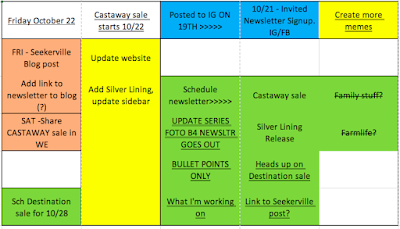
Unlike the example of creating 5 meals from our cooked chicken, my chart for this week has been a work-in-progress. It started out with a few boxes, then as new things popped up, I added them in.
Once a project was completed, I highlighted it green. As you can see at the writing of this, there are some yellow boxes that need to be completed. Hopefully, they'll be done by the time this blog post goes life. We can hope! :) But, the most important got marked off. Scheduling a newsletter to go out, and finishing up this Seekerville blog which had a hard deadline of today. Actually, Seekerville is still orange on the chart, or whatever color that is. So, it gets changed to green now. Yay!
No, I'm not usually this organized or detailed. Most of the time, I'd just pencil this stuff on a piece of paper, but when I remembered the workshop where we planned out how to use one topic to query periodicals in different areas with varied subscriber bases (not that I wrote much for magazines), I felt it was a good lesson for us to revisit.
It goes without saying that this is a simple grid that would have been quicker and easier to just pencil on a piece of paper, but knowing I was going to blog about it made the spreadsheet (and screenshots) a better choice. And, we won't even talk about using flowcharts for this. Let's not get TOO crazy. Simple is better.
What are you currently working on where this strategy could help you? This week's meal planning? Promoting your latest novel? Or maybe even just starting a new project? Cleaning house? Decorating for fall? Or maybe just running errands this week, yes? Grab a piece of paper, draw a 6-8 block grid, and get to work.
And just in case you MISSED it, Castaway with the Cowboy
is on sale for .99cents!! Whoot!
>>>> BUY HERE! <<<<
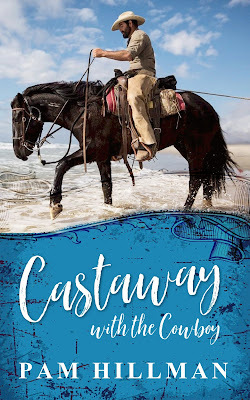
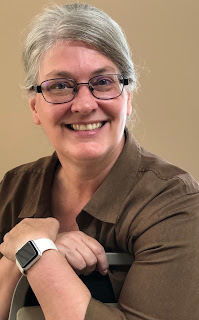 CBA Bestselling author PAM HILLMAN was born and raised on a dairy farm in Mississippi and spent her teenage years perched on the seat of a tractor raking hay. In those days, her daddy couldn't afford two cab tractors with air conditioning and a radio, so Pam drove an Allis Chalmers 110. Even when her daddy asked her if she wanted to bale hay, she told him she didn't mind raking. Raking hay doesn't take much thought so Pam spent her time working on her tan and making up stories in her head. Now, that's the kind of life every girl should dream of. www.pamhillman.com
CBA Bestselling author PAM HILLMAN was born and raised on a dairy farm in Mississippi and spent her teenage years perched on the seat of a tractor raking hay. In those days, her daddy couldn't afford two cab tractors with air conditioning and a radio, so Pam drove an Allis Chalmers 110. Even when her daddy asked her if she wanted to bale hay, she told him she didn't mind raking. Raking hay doesn't take much thought so Pam spent her time working on her tan and making up stories in her head. Now, that's the kind of life every girl should dream of. www.pamhillman.com
October 19, 2021
A Checklist for First Chapters
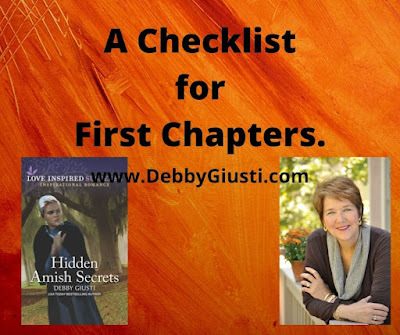
By Debby Giusti
First chapters make or break a book. Start with an opening that grabs the reader.
Luckily, first lines do not have to be written first. Discern where the story’s going and how you want it to unfold. Launch the characters on their journey then go back and rework the opening.
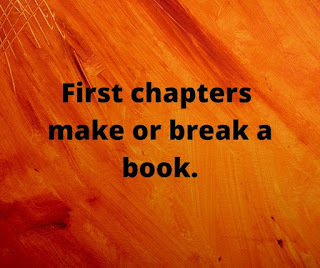
Still stuck on the first line? Shorten, chop, cut. Pare down to a word or phrase. Turn it into a question or place it in quotes. Have the lead character whisper a warning, tell a secret, make a promise. Add action or introspection or a universal truth the protagonist will grapple with and eventually come to accept.
Too wordy? Kill prose that keeps the focus on the writing instead of the story. The opening should be straightforward, not a series of convoluted twists that confuse the reader or make her dizzy. Cut weak modifiers. Choose verbs that pack a punch.
Still not satisfied? Work on something else. Give your internal muse time to sift through your mental database. Often when you return to the opening, the perfect line will bubble up from the depths of your subconscious.
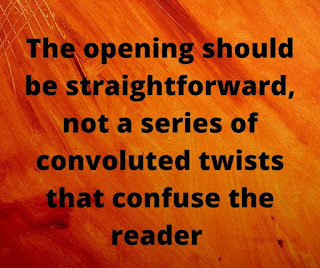
Start the story as the action begins…or even a tad bit later. Christopher Vogler, in THE HERO’S JOURNEY, writes about beginning in the protagonist’s ordinary world where he receives the call to adventure. Once committed, he crosses the first threshold and can’t turn back. The shorter the book, the faster the hero accepts the call and is propelled into the story.
Set the tone and pace and don’t detour off track. Keep descriptions true to the genre. A dark Victorian cottage bathed in shadow is quite different from a warm and inviting bungalow where children romp on the front porch.

Anchor the story in time and place as soon as possible. Again, don’t go overboard. A line or phrase will usually suffice.
Write the initial scene in the lead character’s point of view. Provide clues as to what drives the hero, why he must move forward or what’s at stake if he doesn’t succeed. Hint at his fatal flaw or greatest fear, his Achilles heel or the one facet of his personality he needs to keep hidden. Again less is more. Wet the reader’s appetite; don’t shove the information down her throat. Remember flawed characters are sympathetic characters. Everyone cheers for the underdog.

Introduce the various story arcs within the beginning pages. (What’s a story arc? Inspirational romantic suspense has three arcs or story threads: the romance, suspense and faith.) Where does the protagonist stand initially as far as his relationships with others? What obstacles or threats place him in danger? Does he believe in a higher power or has he turned his back on God?
In a romance, get the hero and heroine together as close to the beginning as possible. Capture their initial reactions and never make falling in love easy. The more unlikely the relationship, the more satisfying the happily ever after.

(Tip: If a female secondary character enters the story before the heroine, make the other woman unsympathetic so the reader knows she’s not the love interest. The converse holds true if a male is introduced before the hero.)
Tease the reader with a hint as to where the story’s going so she can accept or reject the invitation to tag along. Her decision depends on the clues provided in the first chapter. End with a hook that forces her to turn the next page and then another and another. Snag the reader at the beginning, and she’ll stay with you until the end.
Happy writing!
Wishing you abundant blessings,
Debby Giusti
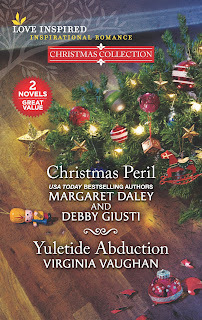
Just in time for Christmas! Three great stories for one low price. The perfect stocking stuffer!
Order your copy HERE!
October 17, 2021
Deciding What Setting to Use, Part 1

Where does your story take place? Is the setting of your story real, imaginary, or somewhere in between?
If you aren't sure, maybe I can help. Here is my take on the different kinds of settings you can use for your novel.
1. Real Settings
There is a distinct advantage in using a real setting for your story. You can go there. Walk the streets. Smell the wind. Listen to the traffic – or non-traffic – noises. You can stop by the local diner and try the daily special. Or if traveling there is impossible, you can do a virtual visit using Google Earth or Google maps street view.
But the disadvantage to using a real place as a setting for your fictional story is that your perception of the area might not match up with someone who actually lives there. Every place is someone’s hometown, and you run the risk of getting some little detail wrong.
It’s a little easier if you’re writing an historical story, since you don’t run as big of a risk of a reader having intimate knowledge of the setting you’re using – especially if your story takes place in an earlier century.
I breathed a deep sigh of relief when I got a letter from a reader after I published my first novel, The Prodigal Son Returns. I had set a few of the scenes in the real town of Goshen, Indiana, in the 1930’s, using my memories from the 1960’s and my dad’s descriptions of his memories of the town from his childhood to add details. But there is always the fear that the descriptions don’t ring true – until I received that note saying that the town I described was just the way this reader remembered it, down to the location of the barber shop on Lincoln Avenue.
Whew!
2. Imaginary Settings
The advantage to creating an imaginary setting completely out of your head is that it’s yours. You get to decide what the weather is like, who lives in this fictional place, and what happens there.
The disadvantage with a setting like this is that you have to create an entire story-world out of your imagination (which is the main attraction for some authors!) Tolkien did this with his Lord of the Rings trilogy. He was so successful in bringing the reader into his story-world that millions of people felt like Middle Earth was a real place – even before the movies were made!
I’ve never written a setting like this. These are usually reserved for science fiction or fantasy stories, but it’s intriguing, isn’t it? To create that perfect world where imaginary beings live and breathe? I might have to try it sometime.
3. Somewhere in between
I have to confess that this is my favorite setting for my stories. This where you take an imaginary setting – a town, ranch, neighborhood – and nestle it into an existing real place.
The advantages of this kind of setting are huge. For instance, in my current Work in Progress, a contemporary cozy mystery, my setting is in the Black Hills. I’ve created my fictional town of Paragon and placed it in a particular spot. Of course, there isn’t a town there. Or even a crossroads. But it is in the middle of the Black Hills National Forest, which satisfies the requirements for the stories in the series.
However, the surrounding area is real. So, my characters can have lunch at Armadillos (my favorite ice cream shop,) or drive into Rapid City to buy groceries at Sam’s Club. And since I live in this real setting, I can be sure that my descriptions of the climate, traffic, the change in the atmosphere when the tourists arrive on Memorial Day weekend, and the EVENT that is the Sturgis Motorcycle Rally are all accurate. When Emma walks out of the Sweetbrier Inn on a late April morning and encounters snow – that’s reality. In a fictional setting.
Another way to use this kind of setting is to set an historical story in a real place. My series, The Amish of Weaver’s Creek, takes place in the very real Amish settlement of Holmes County, Ohio. One reader who had grown up there told me that he felt like he was visiting his childhood home because my descriptions were so accurate.
 A creek in Holmes County, Ohio - the inspiration for Weaver's Creek
A creek in Holmes County, Ohio - the inspiration for Weaver's Creek But Weaver’s Creek and the Amish community surrounding it in a corner of Holmes County is all fictional. I set it a certain distance from Millersburg, Berlin, and Farmerstown – all real towns of the area – and used historical maps to make my descriptions of those towns fit my story setting of the 1860’s. Then I created my own map of the Weaver's Creek area - the farms, the houses, the roads, and where each family lived. The result is a small area my readers can become familiar with inside of a larger area they can visit.
How does that happen? How do our minds gently erase a portion of a map and overlay an imaginary community where none really exists?
How can we all know the Hundred Acre Woods, Hogwarts Castle, Plum Creek, or Deep Valley like they are in our back yards - when we've never actually been there...
 Betsy's home in Deep Valley
Betsy's home in Deep Valley...and if we are able to visit in person, we feel like we've come home.
 Laura's Plum Creek
Laura's Plum CreekThat's one of the intriguing things about reading and the imagination, isn't it?
Next month, I'll be talking about the kind of research that a writer can do to make their settings take on that feeling of reality.
Meanwhile, let's talk about settings. What book setting would you love to visit if you could?
October 16, 2021
Sunday Scripture & Prayer Requests
 Last Supper, by Dagnan-Bouveret, 1896. [PD-US]
Last Supper, by Dagnan-Bouveret, 1896. [PD-US]
James and John, the sons of Zebedee, came to Jesus and said to him,
"Teacher, we want you to do for us whatever we ask of you."
He replied, "What do you wish me to do for you?"
They answered him, "Grant that in your glory
we may sit one at your right and the other at your left."
Jesus said to them, "You do not know what you are asking.
Can you drink the cup that I drink
or be baptized with the baptism with which I am baptized?"
They said to him, "We can."
Jesus said to them, "The cup that I drink, you will drink,
and with the baptism with which I am baptized, you will be baptized;
but to sit at my right or at my left is not mine to give
but is for those for whom it has been prepared."
When the ten heard this, they became indignant at James and John.
Jesus summoned them and said to them,
"You know that those who are recognized as rulers over the Gentiles
lord it over them,
and their great ones make their authority over them felt.
But it shall not be so among you.
Rather, whoever wishes to be great among you will be your servant;
whoever wishes to be first among you will be the slave of all.
For the Son of Man did not come to be served
but to serve and to give his life as a ransom for many."
Mark 10:35-45
The Seekerville bloggers are praying for YOU and for our entire blog community. If you have any special intentions that need additional prayer coverage, leave a request for prayer in the comment section below.
Please join us in praying for our country!God Bless the USA!We are so grateful for all of you—for your friendship and your support!
May the Lord bless you and keep you safe.
October 15, 2021
Weekend Edition


If you are not familiar with our giveaway rules, take a minute to read them here. It keeps us all happy! All winners should send their name, address, and phone number to claim prizes. Please send to Seekerville2@gmail.com. If the winner does not contact us within two weeks, another winner may be selected.
Monday: Jan and Pam teamed up to give us great a checklist for entering contests.
Wednesday: Ruthy rolled into town with a shout out about three new books releasing, "The Path Not Taken", "Embracing Light in Wishing Bridge" and "Jingle Bell Heist"... and the winners of copies of "The Path Not Taken" are Sandy Smith, Denise and Becky! Congratulations, ladies!!!
Friday: Winnie applied Disney's 12 Principles of Animation to Writing. The winners of her 'pick any book from my backlist' giveaway are Edwina and Lucy Reynolds. Congratulations ladies!.

Monday: Jan is here talking about settings. Have you thought about where or when your story is set? Is your setting real, imaginary, or somewhere/when in between?
Wednesday: Debby Giusti will blog about the importance of the first three chapters of your story, and what you need to include to hook your reader and your editor's interest! Friday: Pam

RELEASING ON 10/26!!!! "The Path Not Taken", book two of Ruth Logan Herne's Kendrick Creek series! You can preorder now at Amazon but keep an eye out for it in Walmarts and select groceries nationwide!!!!

A Deja-Vu cover reveal from Jan Drexler!
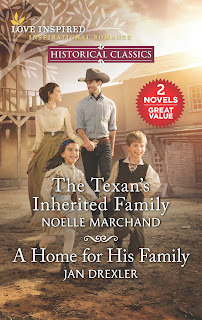
The re-release of "A Home for His Family" is sporting the same cover as the original release back in 2015! How fun is that? Releasing in January, 2022, this two-in-one is available for preorder now!

An Amish Spring Anthology and Debby Giusti is one of the authors.
To learn more join the FB Reader Group
Amish Spring Romance | Facebook
 Available now at your favorite bookstores!
Available now at your favorite bookstores!
Relationship Thesaurus Entry: People Who Are Dating by Becca Puglisi at Writers Helping Writers
4 Key Crossroads Your Protagonist Must Face by Lewis at The Novel Smithy
21st Century Writing by Bob Hostetler at Steve Laube Agency
Managing Deadlines by David Rawlings at Learn How To Write A Novel
7 Ways to Create an Empathetic Antagonist by Sarah Tinsley at Live Write Thrive
Ideas to Help You Create Paperback Book Spines by LA Sartor at Book Brush Blog
NaNoWriMo Prep: Planning Your Novel's Beginning by Janice Hardy at Fiction University
Facebook Deleted My Page! How to Protect Your Social Media Following by Ilma at MailerLite Blog
Rising Action in a Story by Gloria Russell at Write To Done
Don't Give Up On Your Writing Dream by Julie Lavender at The Write Conversation
October 14, 2021
Applying Disney's 12 Principes of Animation to Writing

Hello everyone, Winnie Griggs here. Recently I came across an article that described Disney's 12 principles of animation and as I was reading over the list I was making mental comparisons to how they might apply to writing as well. So today I thought I’d document those thoughts and share them with you.
These principles of animation were first introduced by animators Ollie Johnston and Frank Thomas in their 1981 book The Illusion of Life: Disney Animation. Through examining the work of leading Disney animators from the 1930s onwards, this book shows how Johnston and Thomas boil their approach down to 12 basic principles of animation.
So here they are, along with my writer takeaways.
1. Squash and stretch
This principle states that an object’s mass remains constant no matter how much pressure or tension is applied. So when you stretch something it gets thinner and when you squash it, it gets wider.
My writer takeaway: You need to really understand who your character is at their core, regardless of what image they project.
This principle applies to the fact that you should prepare the audience for action. If you’re going to have a character leap you should show that character bending his knees first.
My writer takeaway: Foreshadowing is important. This goes to that old adage that states if you’re going to shoot somebody in scene 7 make sure you show the gun in scene 3. Foreshadowing is an important device to build tension and suspense, it makes your reader keep turning the pages to see what is going to happen next.
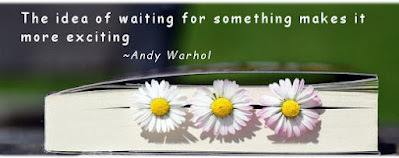
3. Staging
The purpose behind this principle is to direct the viewer’s attention to what is of greatest importance. This can be done by placement in frame, by the use of light and shadow and/or by the angle and position of the camera.
My writer takeaway: Not only is description important, but which elements you chose to describe and the emphasis you place on them is key as well. When using description it is important to identify what you want to describe, why, and what response you want to evoke from the reader
4. Straight-Ahead Action and Pose-to-Pose
This principle states that the artist has two ways to handle drawing animation. The first involves drawing start to finish frame-by-frame resulting in fluid, realistic movements. The second method has the artist draw the beginning frame, the ending frame and then the frames for some of the key motions in between the two. This allows for a little more control in building the dramatic effect in the movement of the character or object
My writer takeaway: There is no one right way to approach writing your scenes. Whether you write linearly, hit the high spots first or approach them in some other fashion, as long as you have command of your process you can pull your reader in and keep them turning the pages then you’re on the right track.

5. Follow through and overlapping action
This has to do with following the laws of physics. Not everything on an object or body will move at the same rate, nor will they stop at the same rate. For instance when a runner stops, their hair or clothing may continue moving.
My writer takeaway: It was a little more difficult for me to find a writer takeaway from this one, but what I finally decided was to liken this to the fact that not every character’s arc will follow the same trajectory or have similar timing. And your character arcs will contribute to but not necessarily follow at the same speed or path as your story arc.
6. Slow in and slow out
This refers to the principles of acceleration and deceleration. Most objects need time to accelerate and decelerate to and from a stop. In the world of animation this is depicted by having more drawings near the beginning and ending of a particular action.
My writer takeaway: The set-up portion of a story will require more focus and detail than the rising and falling action of the middle. And to a lesser extent, this may also be true of your wrap-up at the end.
Most objects follow a specific path or arc when they are in motion. Deviating from this projection without a valid reason makes the movement seem erratic rather than fluid.
My writer takeaway: The events and action from one scene to the next should follow a logical path. This doesn’t necessarily mean expected or predictable (that would be boring!) but when something unexpected does happen, the reader can see how it logically followed from what came before.
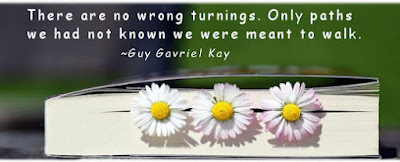
8. Secondary action
This principle states that by adding secondary actions to the main action (e.g. adding swinging arms or whistling when a character is walking) helps to add more realism and dimension to the primary action. However, the secondary action should never diminish the primary one.
My writer takeaway: Secondary characters and subplots are wonderful ways to add context, dimension and color to your story, but they should always remain just that – secondary.
9. Timing
This principle refers to the number of frames dedicated to a specific action sequence which affects the visual speed of that action on film and how realistic that action appears. In animation, timing helps to establish mood, reaction and personality.
My writer takeaway: It’s important to have your protagonist(s) front and center for the majority of your story (a high number of ‘frames’) so that they remain the stars of your story and are not usurped by the secondary cast.
This principle refers to the fact that a perfect imitation of reality can make an animation look static and dull. Adding in just a bit of exaggeration in form or motion adds interest and makes the piece more dynamic.
My writer takeaway: As writer’s we don’t want to depict a perfect imitation of reality either – no trite everyday dialog or depictions of the kind of coincidence that often occurs. By paring things down, focusing on your core story and characters you can provide your reader with the best experience
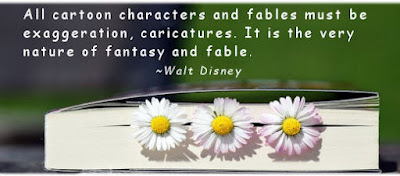 11. Solid drawing
11. Solid drawing
This principle states that before you can succeed in animation, you need to know the basics of drawing, including three dimensional shapes and forms, light and shadow, anatomy in motion and the proper use of symmetry and asymmetry. Consistency in the design of the world being depicted is also important.
My writer takeaway: This one should be obvious – know your craft, the basics of good storytelling. It’s okay to break the rules but only if you understand them first and are subverting them for a reason.
12. Appeal
This principle states that the animated character have something that appeals to the reader, a power to captivate or draw them in. That doesn’t necessarily mean they are sympathetic, villains can also have a strong drawing power.
My writer takeaway: Make certain your story’s characters have the power to engage your readers. Cardboard characters that are one-dimensional, whether all good or all evil, or characters that are too passive or too bland give your reader nothing to engage with, no one to root for or against.
And there you have it! My writer takeaways from Disney’s 12 essential principles of animation. What do you think? Have you heard of these principles before? Do you agree with my takeaways or would you have interpreted any of them differently?
Leave a comment to be entered in a drawing for any book on my backlist.
October 12, 2021
New Ruthy Book!

It's going to be a busy fall for Ruthy readers!
We kick off with "The Path Not Taken", the second book in the Kendrick Creek TN series.... and I love, love, love working in the Smoky Mountains!!!!!! This newest book releases October 26th but you can pre-order on Amazon right now...
We follow up in November with the much awaited "Embracing Light in Wishing Bridge", the beautiful 4th story set in Wishing Bridge, NY, a location that's become a fictional favorite for so many... and the touching and poignant story of a young Amish woman's quest for her stolen babies.... and where that quest leads. In a story of suspense and whole heart, Ruthy's story takes a Solomon-style quandary and a heart-wrenching solution in a story filled with faith, hope and love.
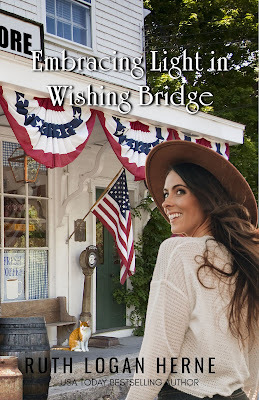
And then her final contribution to the Guideposts "Savannah Secrets" is releasing in December! WHAT A GREAT FOURTH QUARTER!!!! :)
"Jingle Bell Heist" is coming out in December and if you've been following Julia and Meredith's adventures as private investigators, you'll love this holiday story and if you haven't read this series, here's the link to Guideposts... because it is truly so much fun!
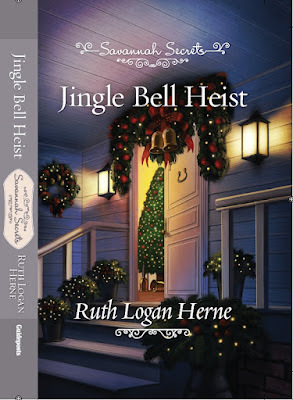
The new year holds more Love Inspired, another Wishing Bridge and a spring mystery so as long as folks keep reading, Ruthy keeps writing!
Here's the blurb for Kendrick Creek's "The Path Not Taken":
A second chance to follow her heart…
in this novel by USA TODAY bestselling author Ruth Logan Herne
She never thought she’d see him again…
Or tell him they have a son.
Ten years ago, Devlyn McCabe refused to let her secret—their child—be the reason Ryland Bauer stayed. Now Rye’s back to make an offer on her property, and she can’t keep hiding the truth. Rye will do anything to be part of his son’s life. But he’ll have to reveal the real reason he left if he wants them to become a family…
I love this beautiful story. It touches heart and soul, it questions choices and opportunities, and it shows how tragedy... the holiday fire that swept down the Smokies and through the little town of Kendrick Creek... doesn't just change the landscape: It changes everything.
Here's a chance to win it before you can buy it!
Leave a comment below and Ruthy will throw your name into the cat dish (I haven't dragged the cat dish out in a while!) and she'll get to the Post Office once pumpkin season is over... she promises! :)
 Bestselling multi-published author Ruth Logan Herne is so blessed to be doing exactly what she loves doing: Writing great books, running a really fun pumpkin farm, taking care of a lot of cute kids as needed and looking forward to all the adventures the good Lord sends her way. The ups... and the downs... the character building moments. God is good! Check out Ruthy's website ruthloganherne.com, email Ruthy at loganherne@gmail.com and/or friend her on Facebook!
Bestselling multi-published author Ruth Logan Herne is so blessed to be doing exactly what she loves doing: Writing great books, running a really fun pumpkin farm, taking care of a lot of cute kids as needed and looking forward to all the adventures the good Lord sends her way. The ups... and the downs... the character building moments. God is good! Check out Ruthy's website ruthloganherne.com, email Ruthy at loganherne@gmail.com and/or friend her on Facebook!

